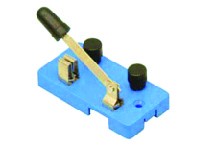

1.5V or 4.5V battery, 1.5V bulb, 3 wires (eg crocodile clips with cable), switch
Pupils already know how to build a functional electric circuit with a bulb. In the following task, they will examine the function of the switch in the electrical circuit. The teacher can guide the pupils to realize that their bulb is on while all parts are connected to the circuit, if the circuit is interrupted, the bulb is no longer lit. In order to make practical use of the electrical energy in the battery to the light energy in the lamp, it is good to have a practical way to switch off the power.

The teacher puts a switch to the pupils in which a mechanical break in the electrical circuit can be easily seen (see picture). Then he leads pupils to make predictions about which of the four proposed electric circuitry designs with the bulb will work and which will not and why. After proposing the predictions and discussing the predictions in which it is the task of the pupils to try to justify their predictions, the pupils will verify the predictions and make a conclusion based on the results of the observation.
In order to make the switch function in the electrical circuit better and more practical, the teacher suggests that they try to create their own functional switch into the electric circuit with the bulb. Their task is to use available materials in the classroom, home and the like. First, they draw their designs and list the necessary tools. Then they present their designs. In the presentation, the other groups are encouraged to look for possible errors in the presented design. Pupils realize their proposed designs at the next lesson to which they will bring the necessary tools, or the teacher enters them with the design of the switch for their homework and test their functionality at the next lesson.